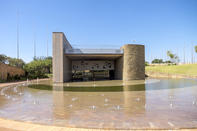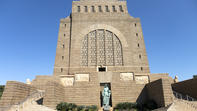Freedom Park
Freedom Park in Tshwane celebrates the ending of apartheid and the building of a free, rainbow nation. Describing itself as a “one-stop heritage precinct” that “strives to accommodate and chronicle all of humanity experiences”.

The Garden of Remembrance is a tranquil space with a symbolic collection of monuments, statues and sculptures, perfect for reflection or prayer. The garden was constructed in 2004, marking the first decade of democracy in South Africa.
The Hapo Museum is also part of the park, with the name meaning ‘dream’ in the Khoisan language. It tells the story of the origins of South Africa, its first inhabitants and showcases its early history. The museum encourages guests to tackle life’s most philosophical questions and reflect on SA’s past.
Ditsong National Museum of Natural History
Follow the evolution of South Africa's fauna and flora at the Ditsong National Museum of Natural History (also known as the Transvaal Museum) in Paul Kruger Street, Tshwane. It is the only natural history museum in Gauteng and was founded in 1892 as the ‘Staatsmuseum of ZAR’.
It offers the local and international community a chance to explore South Africa’s many rich natural histories, including original fossil material. There are educational programmes on hand, as well as talks held by various established researchers and scientists. Learner twitchers please note: ticking off a bird because you’ve seen and heard it in the museum's collection doesn't count, even if it is arranged according to Roberts' Birds of SA.
Voortrekker Monument

The 62-metre-high Voortrekker Monument in Tshwane honours the trekkers who abandoned the Cape Colony between 1835 and 1854 for regions away from colonial authorities. It's loaded with symbolism, from the entrance gates with an assegai motif, to the 64 laager wagons (the number at the Battle of Blood River), to the figures of the trek leaders at the four corners, to the huge Hall of Heroes with its friezes of trek scenes. Each year, at noon on 16 December, the sun shines through an opening in the dome directly onto the centre of the cenotaph onto the words 'Ons vir jou Suid-Afrika' ('We for thee South Africa').